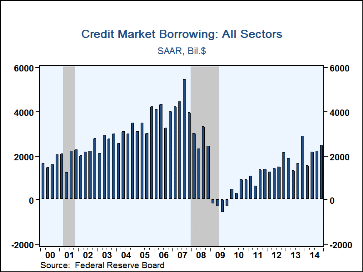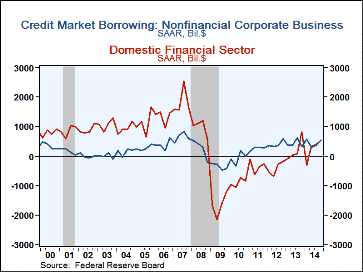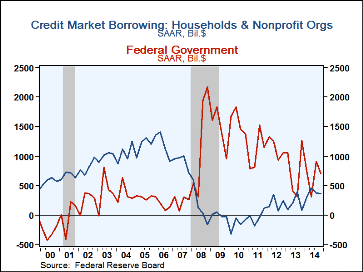 Global| Mar 13 2015
Global| Mar 13 2015U.S. Financial Accounts Show Steadier Gains in Credit Market Borrowing
Summary
The Federal Reserve's financial accounts data (formerly known as the "flow of funds") for Q4 show total credit market borrowing at $2.47 trillion annual rate, up from $2.21 trillion in Q3. For 2014 as a whole, borrowing was $2.10 [...]
 The Federal Reserve's financial accounts data (formerly known as the "flow of funds") for Q4 show total credit market borrowing at $2.47 trillion annual rate, up from $2.21 trillion in Q3. For 2014 as a whole, borrowing was $2.10 trillion, compared to $1.94 trillion in 2013. All the quarterly data here are quoted at seasonally adjusted annual rates.
The Federal Reserve's financial accounts data (formerly known as the "flow of funds") for Q4 show total credit market borrowing at $2.47 trillion annual rate, up from $2.21 trillion in Q3. For 2014 as a whole, borrowing was $2.10 trillion, compared to $1.94 trillion in 2013. All the quarterly data here are quoted at seasonally adjusted annual rates.
The Q4 amount is 14.0% of GDP, up from 12.6% in Q3 and the second largest share since late 2008, in the midst of the financial crisis. Despite a fairly consistent upward trend recently, the latest period remains below a 20-year average ratio to GDP of just over 18%. This ratio peaked at 37.3% in Q3 2007, just at the peak of the previous business cycle, and there were total net paydowns during 2009, in the depth of the recession.
Many press reports of these Financial Accounts highlight the household balance sheet data and the results they show for net worth. This result did improve in the last quarter, but there is clearly much more information in these accounts, and here, we emphasize portions describing broad borrowing aggregates. These had undergone a historically unprecedented contraction during the last recession. So we highlight the recovery in credit market usage as a sign of general rebuilding of economic activity. Perhaps the recent pattern of steadier increases is beginning to show a more standard economic expansion.
The main increase in Q4 borrowing came in nonfinancial corporations, which raised $558 billion, annual rate, compared to $377 billion in Q3. In 2014 as a whole, they raised $449 billion, up modestly from $427 billion in 2013 and the largest annual amount since 2007. Corporate bond issuance in Q4 was $344 billion, up from $209 billion in Q3. Corporations also increased their borrowing from depository institutions, i.e., mostly banks, to $84 billion from just $45 billion the quarter before. Noncorporate businesses also took on more credit market debt in Q4, $287 billion, up from $205 billion in Q3; much of this increase was in bank loans, but mortgage borrowing was also larger.
The other source of larger borrowing in Q4 came in the financial sector, notably government-sponsored enterprises, which issued new debt of $316 billion; this is up from $142 billion in Q3 and by far the largest amount since the recession. Their separate issuance of mortgage-backed bonds, however, remains modest, and that total for 2014, $75 billion, was the second smallest annual amount since 1985.
A couple of major nonfinancial sectors borrowed less in Q4 than they had in Q3, but neither of these was a "small" amount. The federal government used $700 billion - again, as with all these quarterly figures, a seasonally adjusted annual rate - down from $913 billion in Q3. That total for 2014 was $667 billion, down from $759 billion in 2013 and the smallest since 2007; by comparison though, that year saw only $237 billion in federal government borrowing. Also in Q4, the household sector used a bit less credit, $361 billion, than in Q3, $379 billion. The decrease was in net new consumer credit, at $195 billion in Q4 versus $217 billion the period before, and in other depository institution loans, $88 billion versus $97 billion. Notably, household mortgage borrowing picked up, amounting to $68 billion after $66 billion in Q3. Q4 was the third consecutive quarter of net borrowing; this put residential mortgage debt up $23 billion for the year, the first positive year since 2009. By contrast, during the boom in 2005, households borrowed $1.053 trillion in mortgage funding.
The Financial Accounts data are in Haver's FFUNDS database. Associated information is compiled in the Integrated Macroeconomic Accounts produced jointly with the Bureau of Economic Analysis (BEA); these are carried in Haver's USNA database.
Carol Stone, CBE
AuthorMore in Author Profile »Carol Stone, CBE came to Haver Analytics in 2003 following more than 35 years as a financial market economist at major Wall Street financial institutions, most especially Merrill Lynch and Nomura Securities. She has broad experience in analysis and forecasting of flow-of-funds accounts, the federal budget and Federal Reserve operations. At Nomura Securites, among other duties, she developed various indicator forecasting tools and edited a daily global publication produced in London and New York for readers in Tokyo. At Haver Analytics, Carol is a member of the Research Department, aiding database managers with research and documentation efforts, as well as posting commentary on select economic reports. In addition, she conducts Ways-of-the-World, a blog on economic issues for an Episcopal-Church-affiliated website, The Geranium Farm. During her career, Carol served as an officer of the Money Marketeers and the Downtown Economists Club. She has a PhD from NYU's Stern School of Business. She lives in Brooklyn, New York, and has a weekend home on Long Island.







